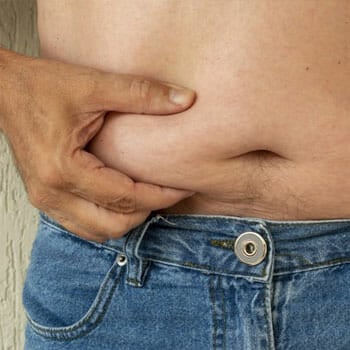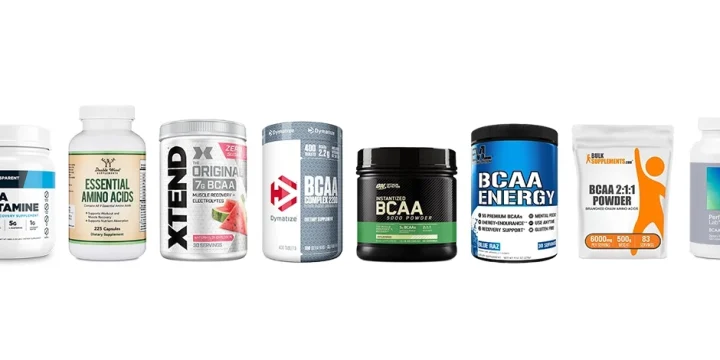There are many ways to measure fat percentage, but how do you know if yours falls within the healthy range?
To learn all about fat percentage and its significance to your health, our team spent a lot of time researching various sources on the subject.
Here’s what we discovered.
Quick Summary
- The ideal fat percentage is dependant on a person's gender, age, body type, physical activity, heredity, and height.
- Body fat percentage can be described as the ratio of fat, compared to total body weight.
- Generally, a healthy body fat percentage ranges from 14-17% for men and 21-24% for women.
- Achieving an ideal body fat percentage is more about consistent healthy lifestyle choices than quick fixes.
What Is A Healthy Body Fat Percentage?

A “healthy” body fat percentage isn’t the same for everyone. It will depend on several factors, including age, gender, height, body type, physical activity, genetics, and heredity.
However, most recommendations are based on gender and age.
Here’s a guideline showing the ideal body fat percentage for men and women per age group.
For Men
| Age | Underfat | Healthy | Overweight | Obese |
|---|---|---|---|---|
| 20-40 | < 8% | 8% - 19% | 19% - 25% | > 25% |
| 41-60 | < 11% | 11% - 22% | 22% - 27% | > 27% |
| 61-79 | < 13% | 13% - 25% | 25% - 30% | > 30% |
For Women
| Age | Underfat | Healthy | Overweight | Obese |
|---|---|---|---|---|
| 20-40 | < 21% | 21% - 33% | 33% - 39% | > 39% |
| 41-60 | < 23% | 23% - 35% | 35% - 40% | > 40% |
| 61-79 | < 24% | 24% - 36% | 36% - 42% | > 42% |
These recommendations show that as you get older, your ideal body fat within these ranges also increases. That’s because a person’s intramuscular fat is prone to increase over time, but certain types of fat, like subcutaneous fat, generally do not increase.
It is important to keep your body fat percentage within the healthy range.
According to a 2017 article published in Imperial College London, an elevated body fat percentage has been proven to be linked to higher cholesterol levels and raised blood pressure, which are both factors that increase the chance of having a stroke or suffering from heart disease [1].
Also, if you often consume more calories than your body demands but don’t burn them off with activity, your fat stores will accumulate and result in weight gain.
What Is Body Fat Percentage?

Body fat percentage is the ratio of fat to total body weight. It includes two types of fat: essential body fat and storage body fat.
Fat usually gets a bad rep, but it isn’t inherently harmful.
Your body needs a certain amount of essential fat to preserve its normal and healthy functioning, so you should have neither too much nor too little of it.
For instance, your body needs the fat you get from fatty fish, nuts, and seeds to make hormones and aid the absorption of fat-soluble vitamins A, D, E, and K.
Fat also protects your vital organs and plays a crucial role in the insulation that regulates your internal temperature.
The other type of fat is storage fat, which is the product of a calorie surplus. When you eat, the calories that aren’t used for energy are converted into the triglycerides that constitute stored fat.
Measuring Body Fat Percentage

There are several different ways to measure your body fat percentage, including skin-fold measurements, getting the circumference of various body parts, and other anthropometric methods that reveal body composition stats.
But if you only have a scale and calculator with you, here’s an easy and old-school method you can use.
1. Check age-specific body fat percentage recommendations
Before crunching the numbers, you should first check the recommended body fat percentile ranges for your sex to know where you fall on the spectrum.
2. Get your weight
Weigh yourself and make sure you get the most accurate measurement possible. To get the best results, step on the scale at the same time every day over a few days to determine your average body weight.
3. Calculate your body mass index (BMI)

Get your weight in pounds and divide that by your height in inches squared. Then, multiply that by a conversion factor of 703.
Here’s a case in point.
If you’re a 130-pound woman who is five feet (60 inches) tall, your calculation should look like this:
[130 ÷ (60)²] 703 = 25.4
Or, more conveniently, you may use our BMI calculator here.
4. Calculate your body fat percentage
Take your BMI result and input the value into the appropriate formula below to get your BFP.
- Men: (1.20 x BMI) + (0.23 x Age) - 16.2 = BFP
- Women: (1.20 x BMI) + (0.23 x Age) - 5.4 = BFP
Using the example above, the BFP of that woman (let’s say she’s 25 years old) would be 30.83%, which is a healthy body fat percentage for that age.
5. Compare your results to the percentiles listed in Step 1
Now that you've calculated your body fat percentage, you have a good indication of whether you should maintain or adjust your current eating habits and physical activity.
If yours falls within the overweight and obese ranges, modifying your workout routine and/or lifestyle may help you achieve your goal.
Related Articles:
Why Do Women Have a Higher Fat Percentage Than Men?

According to a study published by the National Institutes of Health (NIH), women require a higher fat percentage than men [2].
Women need more body fat for ovulation and uterine protection purposes.
As a woman, learning about the natural need for higher body fat for biological functions reshaped my fitness goals to be more health-focused.
Men tend to accumulate abdominal fat since most of their fat is mainly stored in the stomach.
That’s why their ideal body fat percentage also falls within the lower range.
Causes Of Excess Body Fat

What you eat or drink supplies the energy or calories that your body needs to perform.
When it comes to calories, your body operates on a supply and demand system. If the food you consume supplies what your body demands from the movement you do throughout the day, those calories will be converted into energy.
But if you provide your body with more calories than it needs, those extra calories will be stored in fat cells. And if this stored fat isn’t converted into energy later, it will produce excess body fat.
I realized the importance of balancing calorie intake with physical activity when I struggled with excess body fat due to a sedentary lifestyle.
Fat can be stored under your skin or around your internal organs, so you can’t really make assumptions just by looking in the mirror. That means a person can look fit and be a healthy weight for their height but still carry a high level of body fat.
References:
- https://www.imperial.ac.uk/news/181111/fat-increased-risk-heart-disease/#:~:text=Storing%20too%20much%20fat%20in,to%20disease%20and%20poor%20health.
- https://pubmed.ncbi.nlm.nih.gov/11706283/
About The Author
You May Also Like






